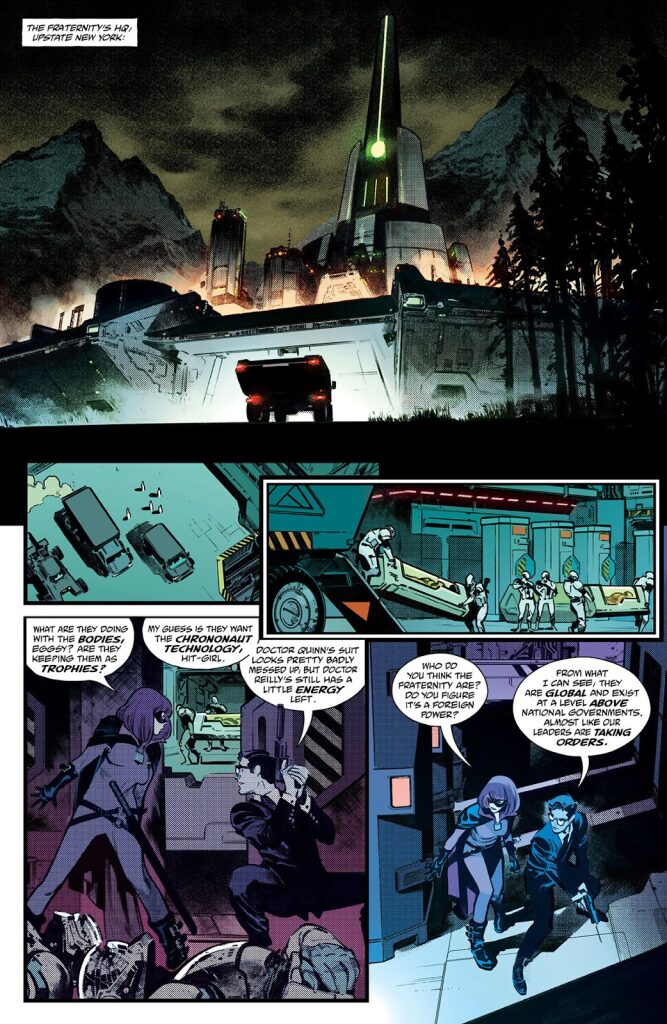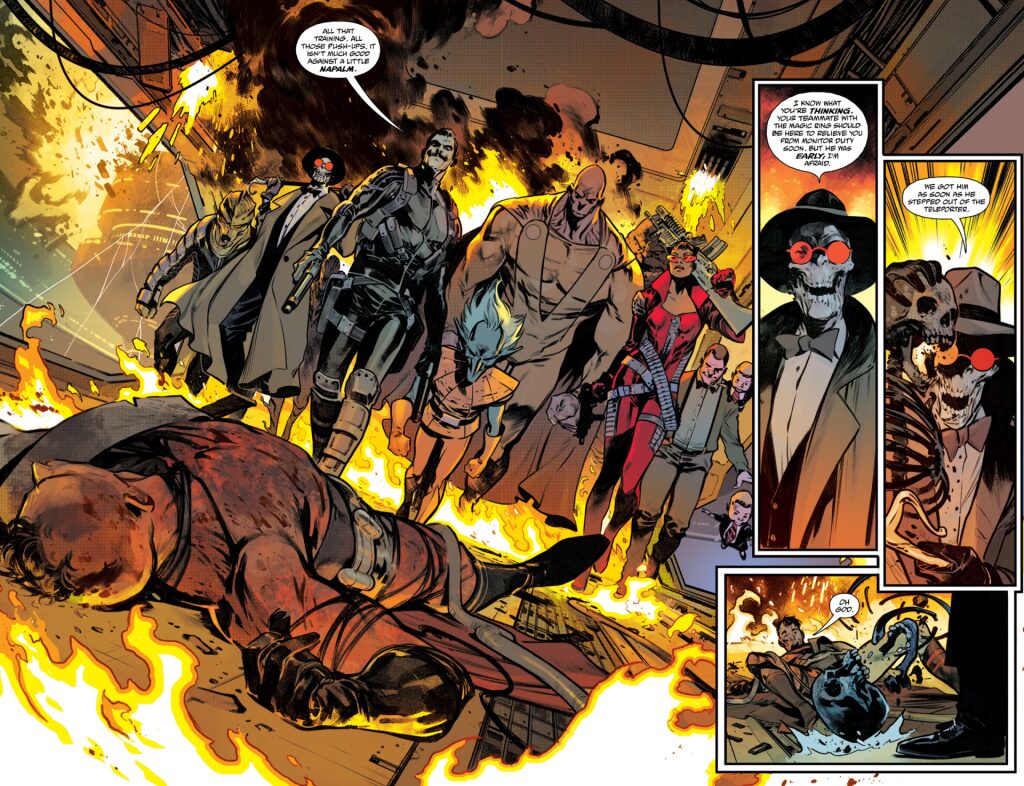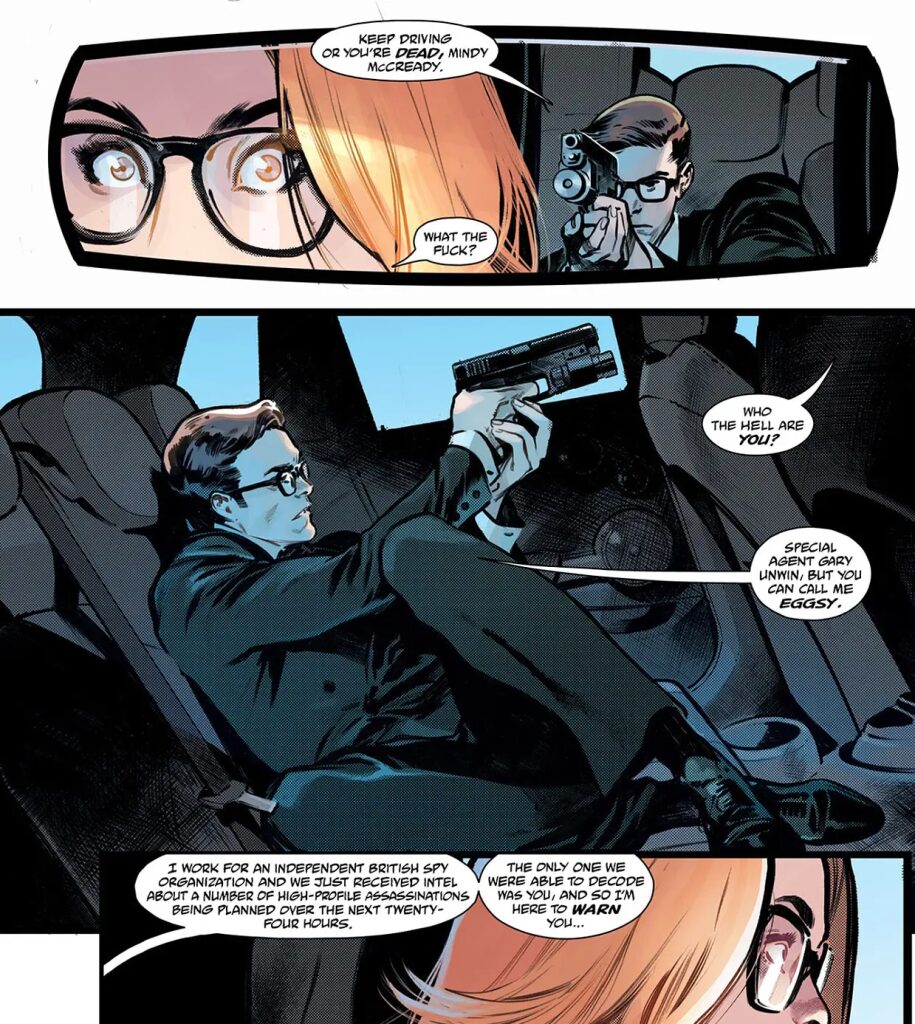Writer: Mark Millar
Artist: Pepe Larraz
Image Comics, December 2023

The promotional copy for this collected edition of Big Game, written by Mark Miller and with art by Pepe Larraz, reads as follows:
Collecting the smash hit crossover event of 2023 where over twenty Millarworld franchises are brought together for the first time and chaos ensues. This is Nemesis versus Kick-Ass, Kingsman, Superior, The Magic Order, Huck, the Night Club and all your favorite characters from our comic books, movies and TV shows. Written by superstar writer Mark Millar (Civil War, Old Man Logan) and Marvel superstar artist Pepe Larraz (X-Men), this series is being released on the 20th anniversary of Millarworld’s first ever book WANTED.

In his book of commentary and interviews entitled Come in Alone, published in 2000, writer Warren Ellis interviewed Mr Millar. Mr Ellis asked the question: so what makes a good comic book? Mr Millar replied, “A good writer, a good artist, and an editor who trusts them and himself enough to stand back and let them shine. It’s that simple.” Mr Millar went on to establish Millarworld, where as owner he did not need to suffer any sort of meaningful editorial interference at all, and has been extremely prolific over the past 23 years.

Big Game is made up of a variety – perhaps, almost all – of Millarworld stories. Notwithstanding Mr Millar’s long reputation as a comic book shockjock, some of these are very good. We have favourably reviewed many of them:
- The Magic Order – see https://www.worldcomicbookreview.com/2023/07/05/the-magic-order-volume-2-review/
- Nemesis and Nemesis Reloaded – see https://www.worldcomicbookreview.com/2020/09/11/happy-10th-birthday-nemesis/ and https://www.worldcomicbookreview.com/2023/07/31/nemesis-reloaded-review/
- Huck – see https://www.worldcomicbookreview.com/2017/09/09/remedy-huck-volume-1-review/
- Prodigy – see https://www.worldcomicbookreview.com/2018/12/29/prodigy-1-review/
- Empress – see https://www.worldcomicbookreview.com/2016/05/17/empress-1-2-mark-millar-delivers/
- Sharkey the Bounty Hunter – see https://www.worldcomicbookreview.com/2019/03/25/sharkey-the-bounty-hunter-1-review/
- Hit Girl – see https://www.worldcomicbookreview.com/2018/02/26/hit-girl-1-review/
- Wanted. Big Game is more firmly rooted in the world of Wanted than anything else. One of the engaging aspects of Big Game is that, as some sort of director’s cut, it fills key scenes from Wanted. We see in Big Game the moment of triumph as The Fraternity overcome Wanted’s version of Batman by using napalm on Wanted’s version of the Justice League satellite. True to his gruesome depiction in Wanted twenty years ago, Mr Rictus shakes the scorched skull and spine of Wanted’s version of Green Lantern like it is a baby’s rattle. We also learn that Bobbie Griffin, an obvious doppelgänger for Barbara “Batgirl” Gordon, has survived and runs an underground network aimed at subverting The Fraternity. Bobbie plays an important role in Big Game: Mr Millar seems to doff his hat to one of DC Comics’ most likeable and resilient characters. At one stage, one of the bad guys mutters, “Bobbie Griffin is the one I’m worried about. She’s the last of the old-school superheroes they used to fight and…” (These are his last words, as he is immediately thereafter machine gunned by Hit Girl.)

But what of the grand purpose of the title? When an orchestra warms up, each of the musicians runs through scales and checks their instruments in their own way. Only the conductor brings order to the chaos. Reading Big Game was akin to the pre-performance cacophony of the orchestra. We can recognise and hear the strings, the brass section, percussion and so on. Some of it is wondrous. But the conductor is missing. At no stage do we get a sense of flow and rhythm. Importantly, no one receives credit as “editor” on the title. We think that shows.
There are fun, intriguing Millarworld stories which have been published over the past two decades since that business’ creation, and some of those are very well suited to a crossover (Eggsy from The Kingsmen in particular works very well with Hit Girl, and the dialogue between Cordelia Moonstone from The Magic Order with Kick Ass is both sentimental and fulfilling to Kick Ass’ fans.)
But some of the interactions in Big Game are jarring. Sharkey the Bounty Hunter’s appearance is completely contrived, without even much of a pretense of anything but a box-ticking exercise. And unless you have actually read all of the Millarworld titles, some of the plot will be bewildering. (We have no idea what the fairyland / Valhalla decapitation in the very final pages was all about.)
Otherwise, Mr Millar relies upon the superhero genre’s box of tricks to deliver on what he has promised. Good versus evil is the easiest conflict drama to write, but with such a deep bench, there could have been extra sides to the conflict other than “the good guys”, “the bad guys”, and “the bad guys from 65 million years ago”. Nemesis, for example, need not have sided with anyone. As the world’s most dangerous man, and an inherent loner, the thrill of the kill in this instance could have been a hunt for Wesley Gibson. Gibson is much better prey than the police commissioners Nemesis pursued in his own title. This would have opened up another front for The Fraternity as they otherwise go about disposing of the latest clutch of superheroes. The Magic Order might have been intensely suspicious of The Night Club, and The Chrononauts’ technology might have been pursued by all of the factions as they endeavour to change the past. It does not take much imagination to conjure other lethal tensions amongst the players. An editor might have pointed that out.
Time travel was going to be inevitable to bring in the world of Empress, and The Chrononauts’ characters were the obvious means of facilitating that (it is all there in the name). But the bouncing around in continuity here is amongst the worst of excesses seen in titles like Marvel Comics’ X-Men. When Hit Girl is shot dead by Wesley Gibson, we are shocked… until it is revealed that the murdered character is an earlier version from the disrupted timeline.
In addition to time travel, the resolution of the story, and Kick Ass’ final destiny, is dependent upon the intervention of The Magic Order. And here we hit a significant plot hole. The Magic Order will not interfere in a threat unless the threat is magic in nature. Cordelia Moonstone at one stage threatens to kill Wesley Gibbs, standing next to him, undetectable and with a wand pointed to his head. She is reprimanded: “Don’t talk crazy, Cordelia. You know better than anyone what happens to the world when we break the rules. The Magic Order has to sit through wars and famines and anything else that isn’t a supernatural enemy. Wesley Gibson might be a son of a bitch but he’s only a human threat and that’s outside our jurisdiction.”
Later, Moonstone has sat down on a park bench to console Kick Ass over his failure to make the epic battle. It is entertaining, chatty dialogue, which is one of Mr Millar’s fortes. “It’s our team’s job to save the world, but only when the threats are monsters and supernatural entities.” Kick Ass objects, “But there is a magical threat…. He’s formed a pact with Diabolos the Sorcerer. It’s all over the Internet.” Moonstone takes issue: “Yeah but he isn’t using real magic. This is superheroes versus alien energy. He’s only a wizard in the loosest sense of the word.” Kick Ass pulls her up: “He’s literally called Diabolos the Sorcerer, Cordelia. Are we really going to argue over semantics?” And with that, The Magic Order joins the fray and turn the tide.
But let’s nitpick. One of the contributors to The Fraternity’s victory back in 1987, described in Wanted, was a “fifth dimensional imp”. This is Mr Millar’s substitute for Mr Mxyzptlk, a magical adversary of Superman. (We can see him, blue and malevolent, in the flashback pages above.) Indeed, the imp at least partly responsible for humanity’s mass amnesia following The Fraternity’s ultimate victory. If there was ever a time for The Magic Order to lean in, it was then.
But we were not promised editorial seamlessness, nor pitch perfect coherency, only a spectacle with lots and lots of characters. Fans of Millerworld’s universes, of Mr Millar’s hyper-swaggering villain dialogue, and of artist Pepe Larraz’s dynamic realism and compelling visual perspectives, will enjoy this collected work.




